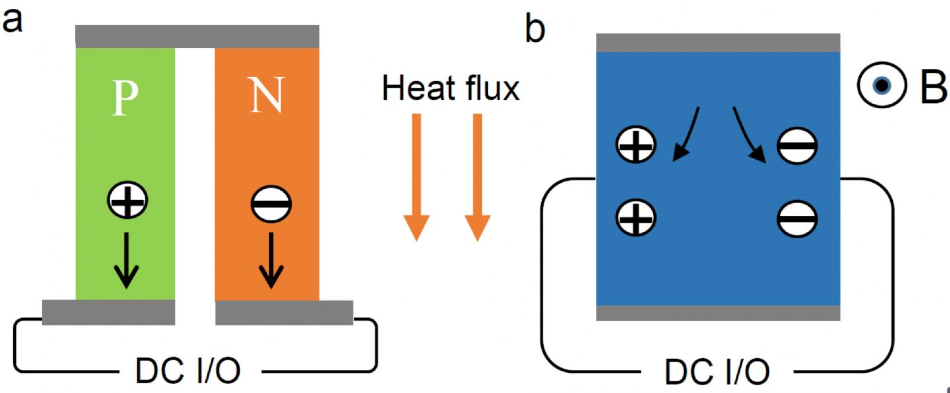Jan 2 2020
A specific material’s thermoelectric conversion efficiency is defined by the value of its thermoelectric figure of merit, zT. The thermoelectric figure of merit is a complex function that involves the absolute temperature and various pertinent transport properties such as the thermal and electrical conductivities, and the Seebeck coefficient.
 Schematics of longitudinal (a) and transverse (b) thermoelectric modules. While n- and p-type materials are needed for the longitudinal thermoelectric module, one material with compensated electrons and holes suffices in the transverse case. Image Credit: ©Science China Press.
Schematics of longitudinal (a) and transverse (b) thermoelectric modules. While n- and p-type materials are needed for the longitudinal thermoelectric module, one material with compensated electrons and holes suffices in the transverse case. Image Credit: ©Science China Press.
In general, these quantities are measured in parallel to each other, which reflects the longitudinal thermoelectric effect.
In traditional thermoelectric materials, the optimization of zT is hampered by major drawbacks. For example, one arises from the charge compensation of electrons and holes that contribute to the Seebeck effect in opposite ways. The other one is the Wiedemann-Franz law that essentially connects the thermal and electrical conductivity, rendering independent optimization of both the quantities unachievable.
A recent study by J. S. Xiang et al. reported in Science China Physics, Mechanics & Astronomy has shown a considerably larger transverse figure of merit in a topological semimetal under low magnetic fields, with respect to its longitudinal equivalent.
This just simulates the considerably larger transverse (Hall) conductivity over its longitudinal equivalent that is commonly noticed in various topological semimetals under low fields.
In topological semimetals, the large transverse zT values arise from some of the intrinsic properties. These are the coexistence of electrons and holes which, in terms of transverse thermoelectricity, will additively contribute to one another. Here, the high charge mobility that is topologically protected is mostly free of the lattice defect.
In fact, Cd3As2, a Dirac semimetal on which this study focuses, has extremely high electron mobility despite its insignificant lattice thermal conductivity due to this reason.
More fascinatingly, it is possible for topological semimetals to have an excess transverse thermoelectric effect, called anomalous Nernst effect, which arises from the prominent Berry curvature close to the Fermi level. Moreover, if one takes a magnetic topological semimetal into account, the large transverse thermoelectricity arises when the external field is absent.
As described in the paper, the transverse thermoelectric effect provides some more benefits over its longitudinal equivalent: two (n and p) types of thermoelectric materials are not required to develop one device.
This is due to the fact that the thermal and electrical currents are decoupled and orthogonal in this case. This enables the low thermal conductivity and high electrical conductivity preferred for a large transverse figure of merit to be easily achieved through the use of an anisotropy compound.
This study was financially supported by the Ministry of Science and Technology of China (Grant Nos. 2017YFA0303100, and 2015CB921303), the National Natural Science Foundation of China (Grant Nos. 11774404, and 11474332), and the Chinese Academy of Sciences through the Strategic Priority Research Program (Grant No. XDB07020200).